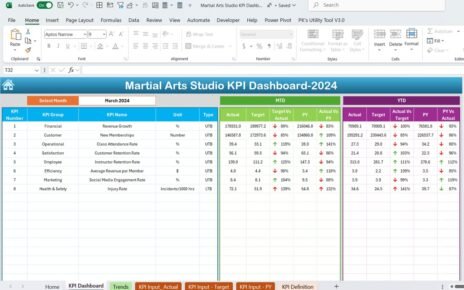In the fast-evolving world of mass media, tracking and analyzing Key Performance Indicators (KPIs) is essential for staying competitive. With a well-designed Mass Media KPI Dashboard in Excel, you can quickly assess your progress on various metrics, helping you make informed decisions and refine your strategy. This article will walk you through a powerful and customizable Excel template for managing Mass Media KPIs, covering essential features, best practices, and improvement opportunities.
Click to buy Mass Media KPI Dashboard in Excel
Introduction
In today’s media landscape, measuring KPIs is not just beneficial; it’s crucial. Mass Media KPIs help organizations track engagement, reach, conversion rates, and other essential metrics that directly impact performance. Our Mass Media KPI Dashboard in Excel is a comprehensive tool that enables you to monitor these KPIs effectively. Let’s explore how each element of this dashboard supports media analysis and helps you keep up with industry demands.
Key Features of the Mass Media KPI Dashboard
Click to buy Mass Media KPI Dashboard in Excel
This dashboard offers seven key worksheet tabs, each meticulously designed to simplify your KPI tracking and analysis.
Home Sheet
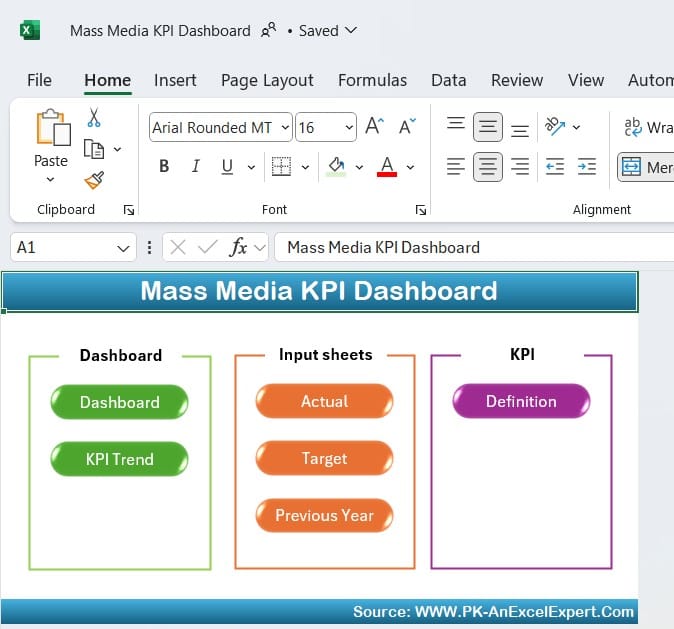
The Home sheet serves as an interactive index for easy navigation. With six buttons, you can jump to any specific sheet, saving you time and allowing for quick access to vital information.
Click to buy Mass Media KPI Dashboard in Excel
Dashboard Sheet Tab
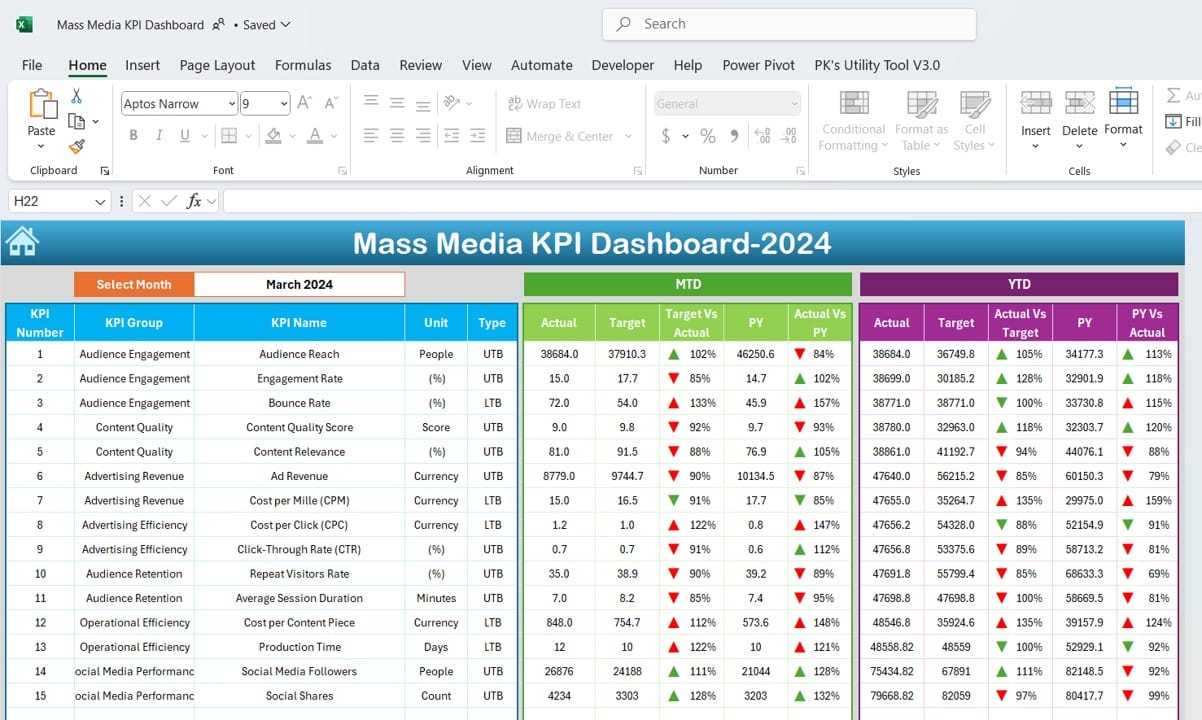
The Dashboard sheet tab is the core of this tool. Here’s what it offers:
- Month Selection: Choose any month from the drop-down in cell D3 to filter data. The dashboard will automatically update to display metrics for the selected month.
- Metrics Overview: View MTD (Month-to-Date) and YTD (Year-to-Date) metrics, including Actual, Target, and Previous Year (PY) data. This view helps compare current performance with both targets and past achievements.
- Conditional Formatting: Get instant visual feedback with up and down arrows indicating Target vs. Actual and PY vs. Actual performance.
Click to buy Mass Media KPI Dashboard in Excel
KPI Trend Sheet Tab
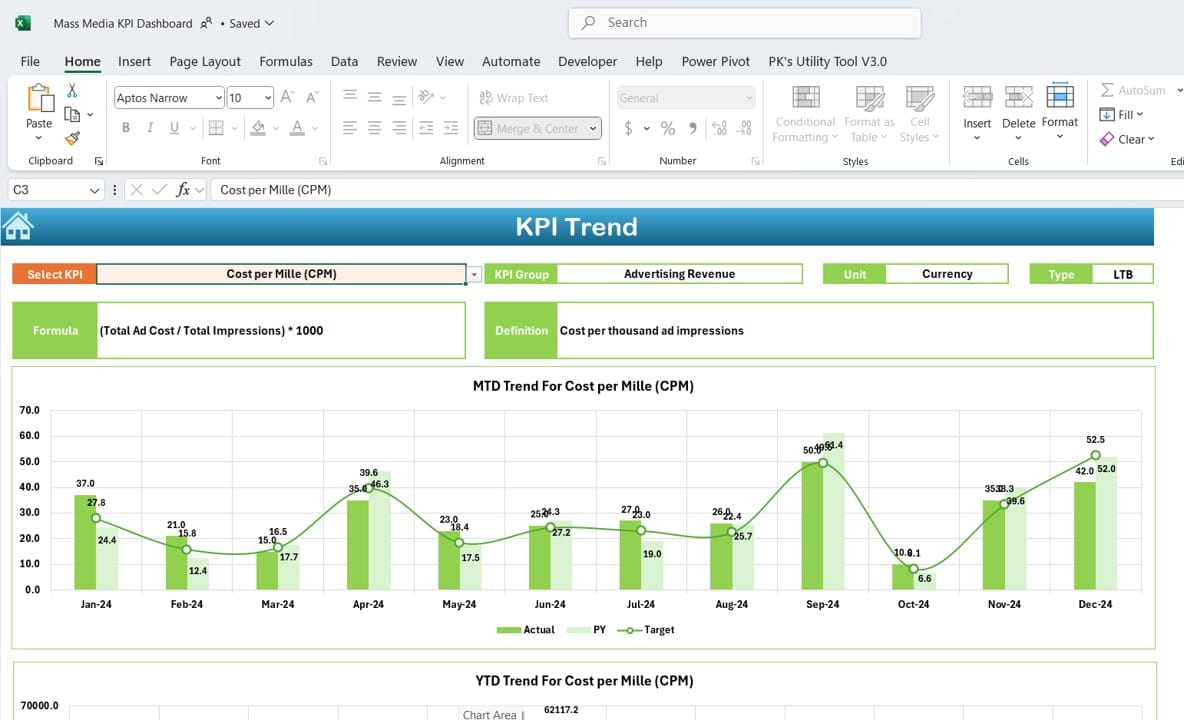
The KPI Trend sheet allows you to track KPI performance trends over time:
Click to buy Mass Media KPI Dashboard in Excel
- KPI Selection: Pick a KPI from the drop-down menu in cell C3 to focus on a specific metric.
- KPI Details: This section shows the KPI Group, Unit, Type (whether higher or lower values are preferred), Formula, and Definition.
- Trend Analysis: Observe MTD and YTD trends for Actual, Target, and PY values through dynamic charts, enabling clear insights into historical patterns.
Actual Numbers Input Sheet
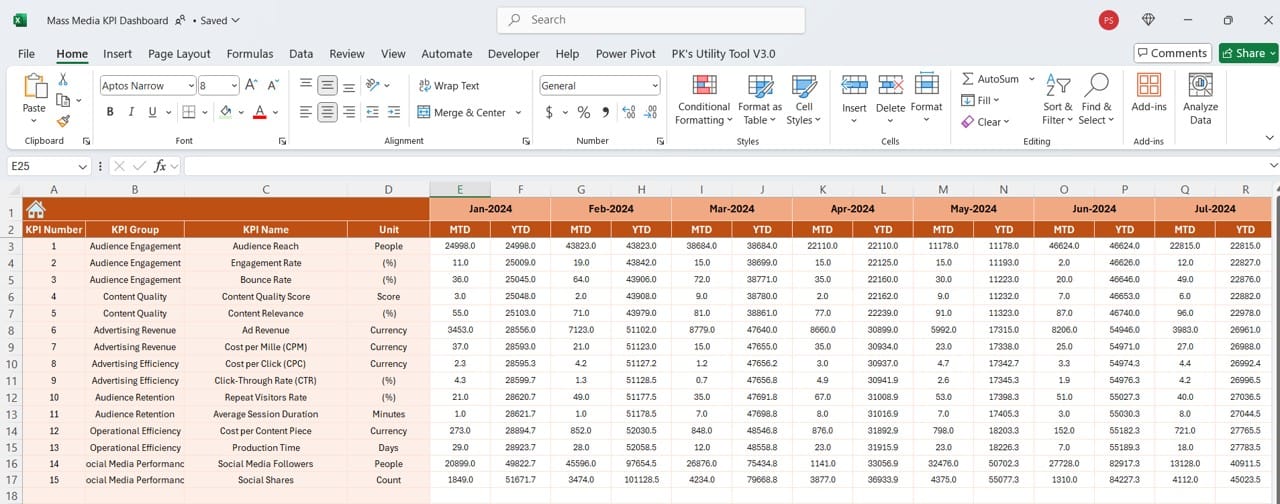
In this sheet, you enter the actual MTD and YTD figures for each KPI by month:
- Month Setup: Adjust the month on cell E1 by inputting the first month of the year. All metrics will align with this setup for consistent tracking.
Target Sheet Tab
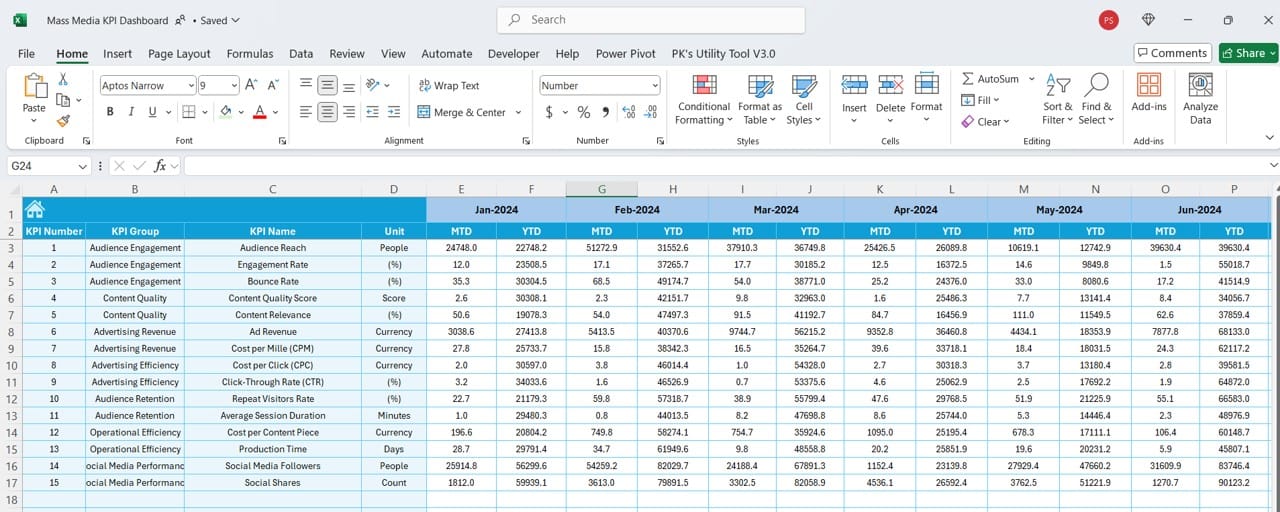
Enter monthly MTD and YTD targets for each KPI in this sheet:
Click to buy Mass Media KPI Dashboard in Excel
- Easy Data Entry: Organize your KPI goals, ensuring your targets are clear and aligned with actual performance data.
Previous Year Numbers Sheet Tab

In this sheet, record the Previous Year’s (PY) data, mirroring the current year’s setup for easy comparison:
- Historical Context: Compare past and present performance to understand growth or areas that need improvement.
KPI Definition Sheet Tab
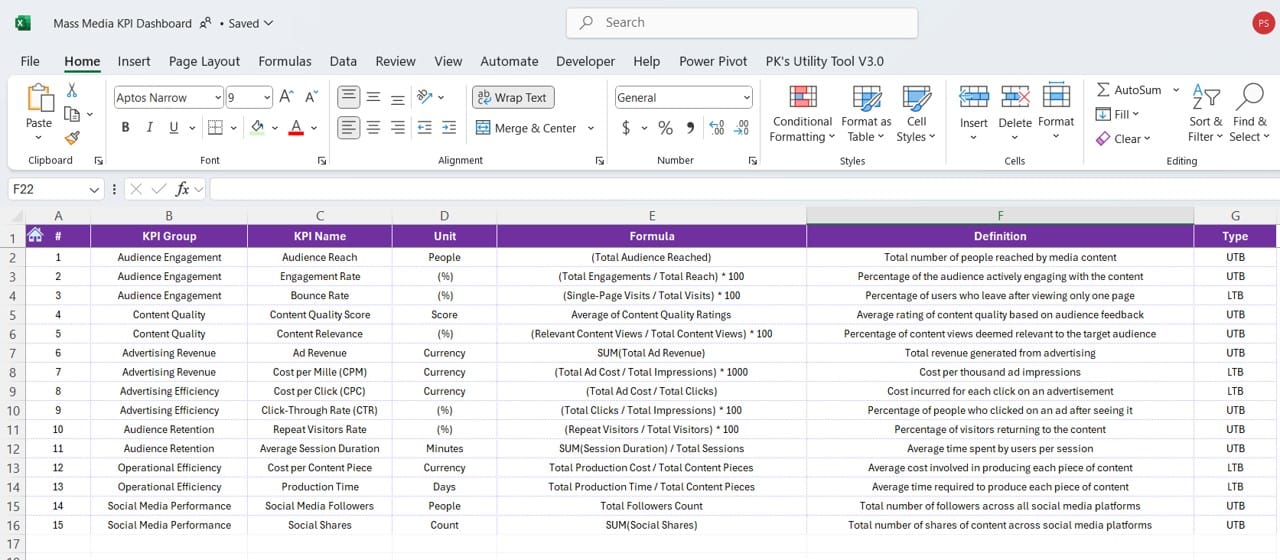
Define each KPI here, ensuring clarity and consistency across all stakeholders:
- KPI Setup: List the KPI Name, Group, Unit, Formula, and Definition, making it easy for users to understand what each metric represents.
Click to buy Mass Media KPI Dashboard in Excel
Advantages of Using a KPI Dashboard in Mass Media
A well-constructed KPI dashboard offers several benefits for media organizations:
- Centralized Data Access: Access all KPI data in one place, making it easy to view metrics without switching between multiple tools.
- Real-Time Tracking: Monitor your progress against monthly and yearly targets, ensuring you stay on top of your goals.
- Enhanced Decision-Making: Use data-driven insights from the dashboard to refine strategies, allocate resources efficiently, and improve overall performance.
Best Practices for Creating a Mass Media KPI Dashboard
To maximize the effectiveness of your Mass Media KPI Dashboard, follow these best practices:
- Keep it Simple and Accessible: Avoid overcrowding the dashboard with unnecessary information. Focus on KPIs that directly impact your goals.
- Use Clear Labels and Descriptions: Clearly define each KPI and provide descriptions, so all users understand the metrics without confusion.
- Incorporate Visual Indicators: Conditional formatting and trend charts can help users identify trends and issues instantly.
- Automate Data Updates: Where possible, link your dashboard to real-time data sources or automated feeds for up-to-date metrics.
Opportunities for Improvement in Your KPI Dashboard
Click to buy Mass Media KPI Dashboard in Excel
Even the best dashboards can benefit from enhancements. Here are a few ideas to keep your KPI dashboard evolving:
- Integrate Additional Metrics: As your organization grows, you may need to add new KPIs to reflect expanded goals and performance areas.
- Add Comparative Views: Consider adding year-over-year or month-over-month comparison charts to gain further insights into your data.
- Leverage Interactive Filters: Allow users to filter data by region, campaign type, or platform to get a deeper understanding of specific segments.
- Optimize for Mobile: Ensure your dashboard is viewable on mobile devices, allowing remote access and flexible data viewing for all team members.
Conclusion
A Mass Media KPI Dashboard in Excel is a powerful asset for any media organization. This dashboard not only enables real-time performance monitoring but also helps teams make informed decisions based on concrete data. By tracking both MTD and YTD metrics, this dashboard facilitates quick insights and long-term strategic planning, setting a solid foundation for sustained media success.
Frequently Asked Questions (FAQs)
Q1: What are the key KPIs for a mass media dashboard?
A: Typical KPIs include audience reach, engagement rate, ad revenue, and conversion rate. Each KPI provides insights into different areas of media performance.
Q2: Can I customize this Excel KPI dashboard?
A: Absolutely. You can add or remove KPIs, adjust formulas, and format visuals based on your organization’s specific needs.
Q3: How often should I update the dashboard?
A: Ideally, update it monthly to track trends and analyze MTD and YTD performance. However, you may choose to update it weekly for a more frequent view of your KPIs.
Q4: What is the benefit of using Excel for a KPI dashboard?
A: Excel offers flexibility, ease of use, and powerful data visualization tools, making it ideal for KPI tracking without investing in expensive software.
Q5: How can I use this dashboard to improve my team’s performance?
A: Regularly reviewing KPIs can help identify strong and weak areas, allowing teams to focus on what’s working and address areas that need improvement.
This article provides an in-depth overview of the Mass Media KPI Dashboard in Excel, guiding readers on its features, advantages, and best practices, while also offering actionable tips for customization and improvement. Feel free to integrate or modify these insights as needed for your content.
Click to buy Mass Media KPI Dashboard in Excel
Visit our YouTube channel to learn step-by-step video tutorials
View this post on Instagram
Click to buy Mass Media KPI Dashboard in Excel


